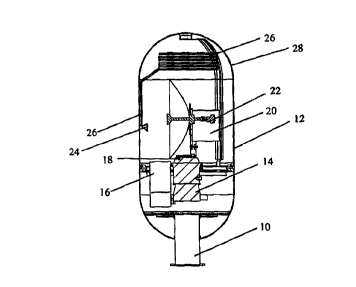Note: Descriptions are shown in the official language in which they were submitted.
_nr~
.,
CA 02325418 2000-09-22
~ WO 99/506'86 PCT/EP99/01979
Radar rangefinder
The present invention relates to a radar rangefinder as
claimed in the descriptive part of patent claim 1.
Such a radar rangefinder is used, for example, in an
arrangement for monitoring a danger area, as is
illustrated and described in DE 196 12 579 A1 from the
same applicant.
In the FMCw radar (frequency-modulated continuous-wave
radar) used there, temperature-dependent and age-
dependent changes normally prevent a desired strictly
linear frequency/time function. The voltage-controlled
oscillators in the available transmitters have non-
linear drive characteristics which are highly dependent
on temperature, load and the operating voltage.
In this context, it is known for calibration methods to
be used, which use a target which produces an echo at a
known distance. This allows self-calibration to be
carried out, using the Hilbert transformation. However,
the arrangement of a target which produces an echo at a
known distance has various disadvantages. Firstly, this
target can be concealed by people or objects moving in
the area. Secondly, raindrops, snow ~or ice in the
measurement path or on the radome housing in which the
radar rangefinder is arranged can adversely affect the
calibration. On the other hand, it is desirable for the
calibration distance to be as great as possible in
order to keep the calibration measurement error as
small as possible.
Against this background, the object of the present
invention is to specify a radar rangefinder having a
reflector for calibration, in which the disturbance
influences mentioned above are all precluded.
CA 02325418 2000-09-22
10
WO 99/50686 PCT/EP99/01979
- 2
This object is achieved according to the distinguishing
features of patent claim 1. Further advantageous
refinements of the radar rangefinder according to the
invention can be found in the dependent claims.
The invention will be described in more detail in the
following text with reference to an exemplary
embodiment which is illustrated in the figures of the
attached drawing, in which:
Figure 1 shows the principle of the design of the
radar rangefinder according to the
present invention; and
Figure 2 shows a block diagram of the components
used in the radar rangefinder shown in
Figure 1.
According to Figure 1, a fixed-position basic unit 14
with associated electronics 16 and a rotating platform
18 is arranged in a protective cover 12, which is
arranged on a base 10 and is referred to in the
following text as a radome housing, and the rotating
platform 18 is fitted with a radar
transmitting/receiving antenna 22 with associated
electronics 20. A horn antenna 24 is arranged inside
the radome housing 12 such that, when the
transmitting/receiving antenna 22 rotates through 360°,
the horn antenna 24 is painted in an angle region which
is located outside the danger area monitored by the
transmitting/receiving antenna 22. A patch antenna
could also be used instead of a horn antenna. The
transmitting/receiving antenna 22 may also be rotated
to a position where it faces the horn antenna 24, for
calibration. A delay line 26 is connected to the horn
antenna 24 and is short-circuited at its end, dictating
a specific shortening factor. Thus, for example, a
delay line 26 with a length of about 8 m corresponds to
an electrical length of 20 m, so that this results in
CA 02325418 2000-09-22
w
WO 99/50686 PCT/EP99/01979
- 3
conditions as if the target which produces the echo
were arranged at a distance of 20 m. The delay line 26
is routed upward into the dome 28 of the radome housing
12, where it is wound up in turns. The delay line 26
may be formed by a round waveguide or a rectangular
waveguide.
Figure 2 shows those components which are located
inside the radome housing 12 on the stationary base
unit 14 and the rotating platform 18.
The rotating platform 18 is driven by a motor 30, which
is driven by a control module 32 via a position
regulator 34 and a power output stage 36. A resolver 38
forms an actual value signal for the position regulator
34. A power supply~unit 40, which is connected to the
power supply via an EMC filter 42, supplies the
required regulated DC voltage. The voltage supply for
the rotating platform 18 as well as a communications
interface for incoming and outgoing data are provided
via a slipring arrangement 44.
The rotating platform 18 is fitted with the
transmitting/receiving antenna 22, an RF
transmitting/receiving module 46, which has a
preamplifier 48 and a voltage-controlled transceiver
50, as well as a digital signal processor module 52,
which comprises an A/D and D/A converter 54 and the
actual signal processor 56.
The danger area to be monitored is bounded by three
triple mirrors 58, 58' , 58", and a target object 60 is
to be detected in this area. The horn antenna 24 and
the delay line 26 are arranged on the inner wall inside
the radome housing 12.
